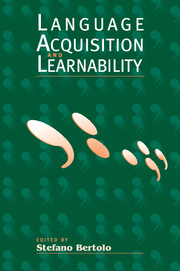1 - A brief overview of learnability
Published online by Cambridge University Press: 15 October 2009
Summary
Applications of formal learning theory to the problem of human language learning can be described as an exercise in which three parties – linguists, psychologists and learnability researchers – cooperatively construct a theory of human language learning and, in so doing, constrain their space of hypotheses by ruling out all the theories that violate one or more of the constraints that each party brings to bear on the problem.
The interaction among these three parties is similar to the interaction that would take place if a rich patron were to ask an architect and a structural engineer to work together to design a museum: the architect would start by designing very bold and innovative plans for the museum; the engineer would remind him or her, calculator in hand, that some of those designs would be physically impossible to build and the patron would visit every so often to make sure that the plans the engineer and the architect have agreed upon would result in a museum that could be built within budget and according to a specified construction schedule. In our case, linguists would correspond to the architect: based on their study of human languages or on more speculative reasons, they specify what they take the possible range of variation among human languages to be.
- Type
- Chapter
- Information
- Language Acquisition and Learnability , pp. 1 - 14Publisher: Cambridge University PressPrint publication year: 2001
- 2
- Cited by



